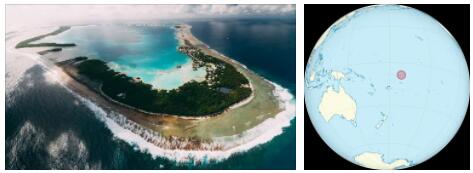Tokelau is a Polynesian word meaning “northern wind”, but in the Tokelau Islands the Tokelau language is spoken, which is quite similar to the language spoken in Samoa. In addition, most people in the Tokelau Islands speak English. This archipelago located in Polynesia in the South Pacific consists of three atolls. Each atoll has a lagoon surrounded by cobs and reefs that are slightly different in length and can reach up to three meters above the water surface. The greater part of this archipelago known as the Tokelau Territory belongs to New Zealand. Swain Island, which is also part of the Tokelau Islands, belongs to American Samoa.
Today, Tokelau residents have New Zealand citizenship. The different societies take care of law and order on their own and it is only in certain specific cases that New Zealand legislation is used. Serious crime is very rare and there are no prisons in the Tokelau Islands. Anyone who commits a crime is publicly reprimanded, fined or sentenced to penal servitude.
Geography and climate
The three atolls that make up the Tokelau Islands are located halfway between Hawaii and New Zealand. The atolls are:
- Atafu Atoll – a part of the archipelago that was once called the Duke of Clarence group.
- Fakaofo Atoll – Once called Bowditch Island.
- The Nukunonu Atoll – also part of what was once known as the Duke of Clarence archipelago.
Lake Swain is culturally, historically and geographically part of the Tokelau Islands but not politically as it has been under American control since 1900. The highest point of the islands is about 5 meters high and the fact that the majority of the land masses are about 2 meters makes the islands particularly sensitive to floods.
The United States also claimed the other Tokelau Islands, but these returned to Tokelau through an agreement in 1979. This agreement established a border between American Samoa and Tokelau. Tokelau’s claim to Swain Island can be compared to the Marshall Islands’ claim to Wake Island, which is administered by the United States. It can not be said that the question of Swainsön is a hot potato for Tokelau’s inhabitants, but at the same time they feel a sense of belonging to the population on Swainsön as they speak the same language and have the same culture, so they do not fully agree that this island should not be politically be part of Tokelau.
The climate is tropical and the average temperature is 28 degrees Celsius. Between November and March, the archipelago can be hit by hurricanes and this has on previous occasions led to waves sweeping over the atolls and destroying sources of fresh water. The hurricane in 1990 led to salt water penetrating into the fresh water on the islands preventing new plants from growing for several months.
Environment in Tokelau
Today, a lot of the original vegetation on Tokelau is gone. It was replaced by coconut plantations. Some plantations are still active while others have been abandoned, which has led to areas with thickets rather than tropical forests as was previously the case. The atolls include a rich wildlife, but some species are threatened by mammals that the population has introduced, such as the Polynesian rat.
